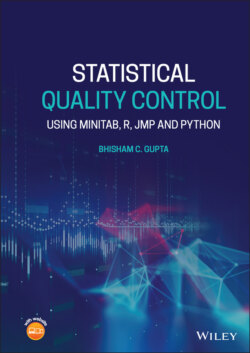Читать книгу Statistical Quality Control - Bhisham C. Gupta - Страница 13
Topics Covered in This Book
ОглавлениеIn Chapter 1, we introduce the basic concept of quality, as discussed by various pioneer statisticians, engineers, and practitioners. A few important pioneers in this area are W. Edwards Deming, Joseph M. Juran, Philip B. Crosby, and Armand V. Feigenbaum. Concepts of quality control and quality improvements are discussed. Finally, we discuss how management can help improve product quality.
In Chapter 2, we introduce the Six Sigma methodology. In the current era, Six Sigma methodology is considered the statistical standard of quality. During the past three decades, Six Sigma methodology has become an integral part of many manufacturing and service companies throughout the world. The benefits of Six Sigma methodology are also discussed.
In Chapter 3, we introduce the different types of data that we encounter in various fields of statistical applications, and we define some terminology, such as population, sample, and different measures. We then introduce various graphical and numerical tools needed to conduct preliminary analyses of data. We introduce the statistical software packages Minitab version 19, Rx64 3.6.0. Finally, some discrete and continuous probability distributions commonly encountered in the application of SQC are discussed.
In Chapter 4, we study different types of sampling methods – simple random sampling, stratified random sampling, cluster random sampling, and systematic random sampling – that are encountered whenever we use sampling schemes to study specific populations. Then we discuss how estimates of various population parameters are derived under different sampling methods.
In Chapter 5, we discuss Phase I control charts for variables. Phase I control charts are used to detect large shifts in a given process in any manufacturing or service industry. Large shifts usually occur when a process is either brand‐new or has undergone drastic changes: for example, a new industry is started and/or new machines are installed in an established industry. This also occurs when a significant new technology is introduced. These kinds of changes can also usually occur whenever a high level of administration is changed: for example, a new CEO or CTO (Chief Technical Officer) is hired.
In Chapter 6, we discuss Phase I control charts for attributes. Control charts for attributes are used whenever we collect a set of counted data. Again, Phase I control charts are used to detect significant shifts in a given process established in any manufacturing or service industry.
In Chapter 7, we discuss Phase II control charts to detect small shifts. Small shifts usually occur when a well‐established process has just experienced small changes. Some examples include workers having gone through some kind of training or specific machines having had their annual checkups, calibrations, or renovations, etc.
In Chapter 8, we discuss various types of process capability indices (PCIs). PCIs are used when a process is well established and the manufacturer or a service provider wants to ensure that they can deliver a product that meets the consumer’s requirements. In this chapter, we discuss how to use PCIs to help any given industry avoid the severe consequences of heavy losses. Then we discuss various aspects of pre‐control, which is an important tool in SQC. As we discuss later, in Chapter 9, different sampling schemes are used to sort out the defective parts from shipments. Pre‐control is a mechanism to reduce the amount of sampling and inspection required to validate that a process is producing products consistent with customer’s expectations. In the last part of this chapter, we discuss aspects of measurement system analysis (MSA). Sometimes a measurement system is responsible for the bad quality of a product; proper MSA can avoid a measurement system that may become the root cause of a product’s failure.
In Chapter 9, we discuss various kind of acceptance sampling schemes that are still in use in some places in the world. These schemes were used frequently in the United States during World War II, when armaments and ammunitions were being produced in huge quantities. However, these sampling schemes are currently not very popular since they are sometimes very expensive to use and are often not very effective. The methods discussed in the previous chapters are more effective in achieving processes that produce better‐quality products. Finally, we discuss some sampling standards and plans: ANSI/ASQ Z1.4‐2003, ANSI/ASQ Z1.9‐2003, Dodge’s Continuous Sampling Plans and MIL‐STD‐1235B.
Chapter 10 is available for download on the book’s website: www.wiley.com/college/gupta/SQC. This chapter presents more detail about the statistical software packages used in this text. In Chapter 3, we introduce the statistical software packages Minitab and R; but due to lack of space, certain basic concepts of these packages are not discussed. In Chapter 10, we discuss these additional aspects of Minitab and R. We also discuss two other statistical packages: JMP and Python. Then, using JMP and Python, we study SQC techniques using examples handled earlier in the book with Minitab and R. After going through the material presented in this chapter, you will be able to analyze different data situations using Minitab, R, JMP, and/or Python; cover all of the SQC techniques discussed in this book; and implement them in various sectors whenever and wherever high‐quality products are desired.
